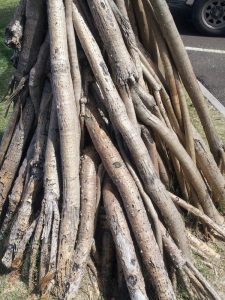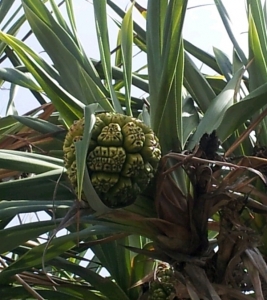I’ve been in Queensland for six months now and having come from the temperate climate of Auckland, I am overwhelmed by the sub-tropical species that crossmy path on a daily basis. Being a frequent visitor to the beach with my new best friend, Master Golden Retriever, you cannot help noticing the pandanus tree. It’s the council’s best friend it would seem.

Coolum Beach’s new ‘Pandanus’ roundabout
Coolum Beach’s first CBD roundabout was finished and open in time for the Christmas rush. The Sunshine Coast Council workers had managed to complete the finishing touches to the roundabout at the intersection of Birtwill Street and David Low Way in this small Queensland beach side town. Pride of place in the middle of the newly built roundabout was a pair of pandanus trees. Wind, drought and saline tolerant were the reasons given by a council spokesman for the choice of tree. They do not stand alone in Coolum, nor indeed along the vast stretch of Queensland’s coastline, for the pandanus tree is an extremely popular planting choice both as a feature tree for a beach entrance, and at the common holiday hot spots.
This sub-tropical small tree is a consistent choice due to its adaptability to several different types of soils, salinity levels and differing rainfall. It is not only its durability to grow and survive in such conditions that makes it a popular choice for landscaping but also its looks, according to Aspect Landscape Contractors who carried out the planting work, “People love the large fruit and prop roots that makes this sub-tropical tree an iconic tree in these parts. Landscapers love them as few struggle to adapt and we have suffered very few loses from the hundreds we have planted over the years” he told me. He added, “They’re one of the few trees that have come from the Pacific Islands that seem to thrive during times of drought”.

Thick prop roots on Pandanus tectorius
The pandanus tree (Pandanus tectorius) grows in maritime, tropical, humid and subhumid climates. The species is well adapted to exposure to strong, often salt-laden winds. They are also well tolerant to extended dry periods of up to 6 months. As with all versatile trees, the soil quality seems to produce few negative consequences to the trees growing success. It grows well in both loam and sandy soils and can sustain periods of waterlogging, whilst appearing to thrive in free draining sandy and poor nutrient soils.
Its appeal for frequent council use was partly also down to its toughness against vandals. The landscaper enthusiastically telling me, “Due to its stout trunk and wide branching thick canopy of almost spiky leaves, people seem to leave them alone”. “Of course the fruit tends to attract a fair bit of attention as you would expect” he added.

Pandanus woody, pineapple-like fruit
The female flower produces the woody pineapple looking fruit which can hang on the branches for more than twelve months. The fruit changes from green to bright orange as it matures and is a popular snack for bats, rats and lizards.
The clearly knowledgeable landscaper remarked, “We have seen a lot more trees popping up in random places, particularly inland which is unusual. We put this down to the weather of last summer when all the rain and wind must have transported the seeds inland. The seeds are located in the prisms of the fruit and can travel great distances”. The prop roots also provide this tree with its unusual appeal. The roots dive down from the main stem into the ground keeping the often top-heavy tree upright and a secure anchor in loose sandy soils and in frequent strong coastal winds. The only real drawback to the tree is its intolerance to cold. It will not survive a frost when small and although found in some parts of northern New South Wales, it is confined to the coast.
This particular roundabout was the first part of a series of sections that the council were working on. As we finished our chat and the sweat had finally dried on the forehead of my helpful landscaper, he jumped in the front of his wagon. A wagon, sure enough with a pair of healthy trees in the back, laden with large pineapple looking fruit…
